G. Henle Musikverlag Piano Music
- p.1 (Al - Ba)
- p.2 (Ba - Ba)
- p.3 (Ba - Be)
- p.4 (Be - Br)
- p.5 (Br - Ch)
- p.6 (Ch - De)
- p.7 (De - Ha)
- p.8 (Ha - Li)
- p.9 (Li - Mo)
- p.10 (Mo - Sa)
- p.11 (Sa - Sc)
- p.12 (Sc - Sc)
- p.13 (Sc - We)
- Next >
-

-
Beethoven, Ludwig Van
Sonata No 12 in Ab, op 26 - Funeral March (Gertsch/Perahia)
Category: Piano Solos
Item: 082482
Grade:
Price: $13.95
Availability: Usually Ships in 24 Hours - View Shopping Cart
-
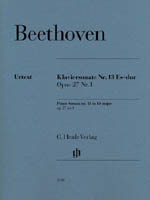
-
Beethoven, Ludwig Van
Sonata No 13 in Eb, op 27, no 1 (Gertsch/Perahia)
Romantic. Beethoven gave this sonata the unusual title "Sonata quasi una Fantasia," which it shares, along with its opus number, with the considerably more famous "Moonlight" Sonata. Both sonatas - along with the preceding sonata with the funeral march op. 26, and the thre sonatas op. 31 soon to follow - usher in Beethoven's conquest of new musical territory in this genre. With a complex structure that oscillates between fantasia and sonata, op. 27 no. 1 has long presented pianists with great int...
Read More
Category: Piano Solos
Item: 127082
Grade: Advanced
Price: $12.95
Availability: Usually Ships in 24 Hours - View Shopping Cart
-

-
Beethoven, Ludwig Van
Sonata No 14 in C#m, op 27, no 2 - Moonlight (Gertsch/Perahia)
Romantic.
Category: Piano Solos
Item: 098621
Grade:
Price: $10.95
Availability: Ships in 6 to 9 Days - View Shopping Cart
-

-
Beethoven, Ludwig Van
Sonata No 15 in D, op 28 - Pastorale (Gertsch/Perahia)
Henle Urtext edition. "My compositions are very profitable for me and I can say that I have more orders than are almost possible for me to fulfil." Beethoven wrote the latter to a friend in 1801. He had only just completed his "Moonlight Sonata" op. 27 No. 2, when he began writing down the first sketches for his Sonata op. 28. Elements of pastoral music, such as the dance-like triple metre as well as pedal notes and fifths in the bass which seem to imitate bagpipes, are reminiscent of the later 6...
Read More
Category: Piano Solos
Item: 072475
Grade: Advanced
Price: $10.95
Availability: Ships in 6 to 9 Days - View Shopping Cart
-

-
Beethoven, Ludwig Van
Sonata No 16 in G, op 31, no 1 (Gertsch, et al)
G. Henle urtext edition. Edited by Norbert Gertsch & Murray Perahia. Fingering by Murray Perahia. Interesting note: Freehand Reis left behind an account of Beethoven's reaction upon receiving and hearing the first published copies of this Sonata. There were an unusually large number of errors in the edition, which made him upset. But at the end of the first Allegro, the publisher had fabricated four additional measures. Upon hearing this played through, Beethoven jumped up and said, "Where the d...
Read More
Category: Piano Solos
Item: 053961
Grade:
Price: $10.95
Availability: Ships in 6 to 9 Days - View Shopping Cart
-

-
Beethoven, Ludwig Van
Sonata No 17 in Dm, op 31, no 2 - Tempest (Gertsch/Perahia)
Category: Piano Solos
Item: 050707
Grade:
Price: $9.95
Availability: Usually Ships in 24 Hours - View Shopping Cart
-

-
Beethoven, Ludwig Van
Sonata No 18 in Eb, op 31, no 3 - Hunting (Gertsch/Perahia)
G. Henle urtext edition. Edited by Norbert Gertsch & Murray Perahia. Fingering by Murray Perahia. With forward and critical commentary. For half a century Henle's edition of the Beethoven sonatas - the "New Testament" of the piano repertoire - has been universally recognized as the stan-dard starting-point for any serious study of these works. Now, with the publication of the three op. 31 sonatas in revised separate editions, we are raising the yardstick another notch: no less a musician than th...
Read More
Category: Piano Solos
Item: 054602
Grade:
Price: $10.95
Availability: Ships in 6 to 9 Days - View Shopping Cart
-

-
Beethoven, Ludwig Van
Sonata No 21 in C, op 53 - Waldstein
G. Henle URTEXT edition
Category: Piano Solos
Item: 013775
Grade:
Price: $11.95
Availability: Ships in 6 to 9 Days - View Shopping Cart
-

-
Beethoven, Ludwig Van
Sonata No 21 in C, op 53 - Waldstein (Gertsch/Perahia)
Romantic. A further edition in Henle's highly regarded Beethoven revisions bears witness to the fruitful collaboration with renowned artist Murray Perahia. As always, Perahia not only provides valuable fingering suggestions but also shares his personal thoughts on this work in a short essay. -the publisher
Category: Piano Solos
Item: 091455
Grade:
Price: $11.95
Availability: Ships in 6 to 9 Days - View Shopping Cart
-
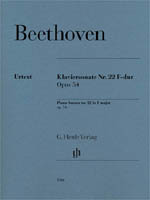
-
Beethoven, Ludwig Van
Sonata No 22 in F, op 54 (Gertsch/Perahia)
Category: Piano Solos
Item: 132350
Grade:
Price: $9.95
Availability: Ships in 10 to 15 Days - View Shopping Cart
-
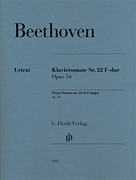
-
Beethoven, Ludwig Van
Sonata No 22 in F, op 54 (Wallner/Hansen)
Category: Piano Solos
Item: 112644
Grade:
Price: $8.95
Availability: Usually Ships in 24 Hours - View Shopping Cart
-

-
Beethoven, Ludwig Van
Sonata No 23 in Fm, op 57 - Appassionata
G. Henle URTEXT edition
Category: Piano Solos
Item: 001884
Grade:
Price: $12.95
Availability: Ships in 6 to 9 Days - View Shopping Cart
-

-
Beethoven, Ludwig Van
Sonata No 24 in F#, op 78 - A Therese (Wallner/Hansen)
Category: Piano Solos
Item: 112645
Grade:
Price: $8.95
Availability: Usually Ships in 24 Hours - View Shopping Cart
-

-
Beethoven, Ludwig Van
Sonata No 25 in G, op 79 - Sonatina (Wallner/Hansen)
G. Henle URTEXT edition
Category: Piano Solos
Item: 013776
Grade:
Price: $8.95
Availability: Usually Ships in 24 Hours - View Shopping Cart
-

-
Beethoven, Ludwig Van
Sonata No 26 in Eb, op 81a - Les Adieux (Wallner/Hansen)
G. Henle URTEXT edition. This famous sonata, one of Beethoven's most popular and characteristic works, has captions for each of its three movements: Les Adieux, L'Absence and Le Retour. An inexpensive single edition from volume 2 of Henle's complete reference edition of the Beethoven piano sonatas. -the publisher
Category: Piano Solos
Item: 041073
Grade:
Price: $11.95
Availability: Ships in 6 to 9 Days - View Shopping Cart
-

-
Beethoven, Ludwig Van
Sonata No 26 in Eb, op 81a - Les Adieux (Gertsch/Perahia)
Romantic. "The farewell / Vienna, May 4, 1809 / on the departure of his Imperial Highness the revered Archduke Rudolph" — Beethoven added this inscription to the manuscript of this sonata. It is today know by its French title les Adieux and numbersamongst the composer's best-loved piano works. The first movement of the sonata was presumably written directly before the archduke hurriedly left Vienna. Rudolph and other members of the imperial family fled to Hungary to avoid having to endure t...
Read More
Category: Piano Solos
Item: 127083
Grade: Advanced
Price: $11.95
Availability: Ships in 10 to 15 Days - View Shopping Cart
-

-
Beethoven, Ludwig Van
Sonata No 27 in Em, op 90 (Wallner/Hansen)
G. Henle URTEXT edition
Category: Piano Solos
Item: 017725
Grade:
Price: $11.95
Availability: Ships in 6 to 9 Days - View Shopping Cart
-

-
Beethoven, Ludwig Van
Sonata No 27 in Em, op 90 (Gertsch/Perahia)
Romantic. "It is, aside from two passages, one of Beethoven's easiest; but as far as the performance of individual passages and its whole spirit is concerned, requires every kind of care," thus wrote a contemporary critic. And it is for this reason that Beethoven's Sonata op. 90 is extremely popular today, both with piano students and also with professional pianists. It provides enough challenges: for example the notorious tenth figures in the left hand and - in the words of a contemporary - "uni...
Read More
Category: Piano Solos
Item: 119803
Grade:
Price: $12.95
Availability: Ships in 10 to 15 Days - View Shopping Cart
-

-
Beethoven, Ludwig Van
Sonata No 28 in A, op 101 (Gertsch/Perahia)
G.Henle Urtext edition. Edited by Norbert Gertsch & Murray Perahia. Fingering by Murray Perahia.
Category: Piano Solos
Item: 067345
Grade:
Price: $10.95
Availability: Ships in 6 to 9 Days - View Shopping Cart
-

-
Beethoven, Ludwig Van
Sonata No 29 in Bb, op 106 - Hammerklavier (Wallner & Hansen)
Category: Piano Solos
Item: 112166
Grade:
Price: $11.95
Availability: Ships in 10 to 15 Days - View Shopping Cart
-

-
Beethoven, Ludwig Van
Sonata No 30 in E, op 109
G. Henle URTEXT edition.
Category: Piano Solos
Item: 013875
Grade:
Price: $12.95
Availability: Ships in 6 to 9 Days - View Shopping Cart
-

-
Beethoven, Ludwig Van
Sonata No 31 in Ab, op 110 (Wallner)
G. Henle URTEXT edition.
Category: Piano Solos
Item: 013876
Grade:
Price: $8.95
Availability: Ships in 6 to 9 Days - View Shopping Cart
-

-
Beethoven, Ludwig Van
Sonata No 32 in Cm, op 111
G. Henle URTEXT edition.
Category: Piano Solos
Item: 013877
Grade:
Price: $11.95
Availability: Ships in 6 to 9 Days - View Shopping Cart
-

-
Beethoven, Ludwig Van
Sonatas ( 2) in E, op 14, no 1 & G, op 14, no 2
G. Henle URTEXT edition
Category: Piano Composer Folios
Item: 013816
Grade:
Price: $8.95
Availability: Ships in 6 to 9 Days - View Shopping Cart
-

-
Beethoven, Ludwig Van
Sonatas ( 3), WoO 47
G. Henle URTEXT edition
Category: Piano Composer Folios
Item: 013845
Grade:
Price: $16.95
Availability: Ships in 6 to 9 Days - View Shopping Cart
-

-
Beethoven, Ludwig Van
Sonatas (2) Nrs 9 & 10, opp 14, nrs 1 & 2 (Gertsch/Perahia)
Includes the 2 Sonatas in opus 14 - number 9 in E (op14/1) and No 10 in G (op 14/2). Edited by Norbert Gertsch & Murray Perahia. Fingering by Murray Perahia. Beethoven only arranged one of his piano sonatas for a different instrumentation: an authentic arrangement of op 14/1 for string quartet still exists (it is published in an appendix to our edition of the String Quartets op. 18, HN 139/9139). He undertook this arrangement to protect himself from those made by others. For this reason he went ...
Read More
Category: Piano Composer Folios
Item: 065955
Grade:
Price: $15.95
Availability: Ships in 6 to 9 Days - View Shopping Cart
-

-
Beethoven, Ludwig Van
Sonatas (32), v.1 (Wallner/Hansen)
G. Henle URTEXT edition. Edited by Bertha Antonia Wallner. Fingering by Conrad Hansen. Beethoven's 32 piano sonatas are often referred to as the "New Testament of Music" (Hans von Bulow). Since the publication of our complete edition in two volumes, experts have praised it as being the most reliable Urtext edition. Its contents: an almost inexhaustible wealth of pianistic, musical flights of inspiration, predominantly high profile works - the Sonatas "Pathetique," "Moonlight," "Storm," "Appassion...
Read More
Category: Piano Composer Folios
Item: 001881
Grade:
Price: $61.95
Availability: Usually Ships in 24 Hours - View Shopping Cart
-

-
Beethoven, Ludwig Van
Sonatas (32), v.1 (Wallner) [without fingering]
Hans von Blow described Beethoven's 32 piano sonatas as "Music's New Testament". Since its first appearance, Henle's complete two-volume edition (our 001881 and 004139) has been valued by specialists as the most dependable Urtext, and belongs in every pianist's library. It contains an inexhaustible treasure of pianistic and musical mastery, setting technically challenging works with a high level of name-recognition, such as the "Pathtique," "Moonlight," "Tempest," "Waldstein," "Appassionata" an...
Read More
Category: Piano Composer Folios
Item: 113461
Grade:
Price: $49.95
Availability: Ships in 6 to 9 Days - View Shopping Cart
-

-
Beethoven, Ludwig Van
Sonatas (32), v.1 - hardbound (Wallner/Hansen)
G. Henle URTEXT edition. Edited by Bertha Antonia Wallner. Fingering by Conrad Hansen.
Category: Piano Composer Folios
Item: 013945
Grade:
Price: $84.95
Availability: Ships in 6 to 9 Days - View Shopping Cart
-
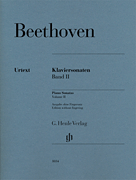
-
Beethoven, Ludwig Van
Sonatas (32), v.2 (Wallner) [without fingering]
Hans von Blow described Beethoven's 32 piano sonatas as "Music's New Testament". Since its first appearance, Henle's complete two-volume edition (our 001881 and 004139) has been valued by specialists as the most dependable Urtext, and belongs in every pianist's library. It contains an inexhaustible treasure of pianistic and musical mastery, setting technically challenging works with a high level of name-recognition, such as the "Pathtique," "Moonlight," "Tempest," "Waldstein," "Appassionata" an...
Read More
Category: Piano Composer Folios
Item: 113462
Grade:
Price: $49.95
Availability: Usually Ships in 24 Hours - View Shopping Cart
-

-
Beethoven, Ludwig Van
Sonatas (32), v.2 (Wallner/Hansen)
G. Henle URTEXT edition. Edited by Bertha Antonia Wallner. Fingering by Conrad Hansen. Beethoven's 32 piano sonatas are often referred to as the "New Testament of Music" (Hans von Bulow). Since the publication of our complete edition in two volumes, experts have praised it as being the most reliable Urtext edition. Its contents: an almost inexhaustible wealth of pianistic, musical flights of inspiration, predominantly high profile works - the Sonatas "Pathetique," "Moonlight," "Storm," "Appassion...
Read More
Category: Piano Composer Folios
Item: 004139
Grade:
Price: $52.95
Availability: Usually Ships in 24 Hours - View Shopping Cart
-

-
Beethoven, Ludwig Van
Sonatas (32), v.2 - hardbound (Wallner/Hansen)
G. Henle URTEXT edition. Edited by Bertha Antonia Wallner. Fingering by Conrad Hansen.
Category: Piano Composer Folios
Item: 013946
Grade:
Price: $77.95
Availability: Ships in 6 to 9 Days - View Shopping Cart
-

-
Beethoven, Ludwig Van
Sonatas, v.2 (Gertsch/Perahia)
Contents: Op.26 thru 54. (thematic index)
(thematic index)
Category: Piano Composer Folios
Item: 128041
Grade:
Price: $52.95
Availability: Usually Ships in 24 Hours - View Shopping Cart
-

-
Beethoven, Ludwig Van
Sonatinas (2) in F & G (Lampe)
G. Henle URTEXT edition. Contents:
• Sonatina in G, Anh. 5/1
• Sonatina in F, Anh. 5/2
Category: Piano Composer Folios
Item: 013878
Grade:
Price: $10.95
Availability: Usually Ships in 24 Hours - View Shopping Cart
-

-
Beethoven, Ludwig Van
Variation Works (3), woo 64, 70 & 77 (Loy/Schildt/Fountain)
Romantic. The compositions united here provide a good overview of the diversity of the variation genre in Beethoven's early piano works - and present such moderate technical demands that even advanced beginners might try their hand at them. Beethoven found the models for these variations in popular song collections (WoO 64 on a Swiss song), contemporary opera performances (WoO 70 on "Nel cor piu non mi sento" by Giovanni Paisiello), and his own compositions (WoO 77 on a theme from the finale of P...
Read More
Category: Piano Composer Folios
Item: 125188
Grade:
Price: $9.95
Availability: Usually Ships in 24 Hours - View Shopping Cart
-

-
Beethoven, Ludwig Van
Variations (3) (Schmidt-Goerg)
G. Henle URTEXT edition. This small volume comprises three variation cycles of Beethoven's which are brought together in Urtext editions that are technically fairly easy to master (level of difficulty 3-5). Two of them, the Variations on a Swiss Song WoO64 and the Variations on an original theme WoO 77, are already marked as "faciles" or "trs faciles" in the titles of the respective first editions. When Beethoven sent a manuscript of the Variations on a Theme from Paisiello's opera La Molinara t...
Read More
Category: Piano Composer Folios
Item: 013806
Grade:
Price: $8.95
Availability: Ships in 6 to 9 Days - View Shopping Cart
-
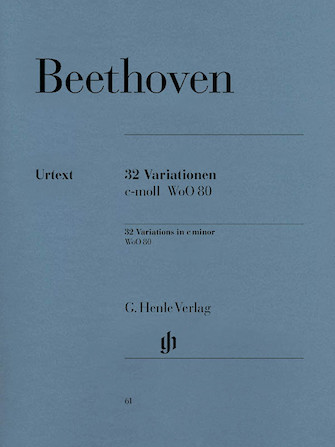
-
Beethoven, Ludwig Van
Variations (32) in Cm, woo 80 (Klugmann)
G. Henle URTEXT edition. Ludwig van Beethoven's 32 Variations on an Original Theme in C minor (WoO 80) for piano, dating from 1806, are both a magnificent concert piece and an outstanding etude. Only with Beethoven can an eight-measure theme contain so much melodic and harmonic energy. The variations, of eight measures each, flow into one another powerfully and without interruption, offering a veritable compendium of Beethoven's piano technique. The effect is of a mighty passacaglia. With the mor...
Read More
Category: Piano Composer Folios
Item: 002522
Grade:
Price: $11.95
Availability: Ships in 6 to 9 Days - View Shopping Cart
-

-
Beethoven, Ludwig Van
Variations (32) in Cm, woo 80 (Loy/Fountain)
Romantic. Among the Variations on an Original Theme, WoO 80 from 1806 constitutes a special case in that Beethoven consciously draws on older practices. A chromatically descending bass line in the theme provides the foundation for the variations, its ostinato-like repetition lending the composition the air of a passacaglia. The revised musical text of the Henle Urtext edition, with an extensive preface and commentary section, was prepared on the basis of the Critical Report in the Beethoven Compl...
Read More
Category: Piano Solos
Item: 125189
Grade:
Price: $11.95
Availability: Ships in 10 to 15 Days - View Shopping Cart
-
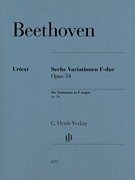
-
Beethoven, Ludwig Van
Variations in F (6), op 34 (Loy/Fountain)
Romantic. Like the "Eroica Variations" op. 35, the Variations op. 34, were composed in 1802 on an original theme. The "new fashion" Beethoven declared for both works to his publisher becomes apparent in opus 34 through the constant change of keys; from one variation to the next, new tone colours and moods continue to unfold, spanning the pastoral and the funereal, while the melody of the theme remains largely unaltered. For the first time, the Variations op. 34, are now available from Henle in a ...
Read More
Category: Piano Solos
Item: 124365
Grade:
Price: $9.95
Availability: Usually Ships in 24 Hours - View Shopping Cart
-

-
Beethoven, Ludwig Van
Variations, v.1 (Schmidt-Gorg)
G. Henle URTEXT edition. Includes: • 10 Variations on La stessa, la stessissima by Salieri WoO 73 • 12 Variations WoO 68 • 12 Variations on a Russian Dance by Wranitzky WoO 71 • 13 Variations on Es war einmal ein alter Mann by Ditters von Dittersdorf WoO 66 • 24 Variations on Venni Amore by Righini WoO 65 • 6 Variations on a Swiss Song WoO 64 • 6 Variations on Nel cor piu non mi sento by Paisiello Wo...
Read More
Category: Piano Composer Folios
Item: 003662
Grade:
Price: $34.95
Availability: Ships in 6 to 9 Days - View Shopping Cart
-

-
Beethoven, Ludwig Van
Variations, v.1 (Schilde/Loy)
Variation form occupied Beethoven throughout his composing career. This first volume of Henle's two-volume edition of all his piano variations includes works from Beethoven's time in Bonn as well as his early years in Vienna, composed between 1783 and 1799. Beethoven mostly took his themes from arias or songs from stage works that were popular at the time. Besides offering simple figurations around the melodic lines, he also made more radical variations of his chosen material, pointing the way fo...
Read More
Category: Piano Composer Folios
Item: 124996
Grade:
Price: $34.95
Availability: Ships in 10 to 15 Days - View Shopping Cart
-
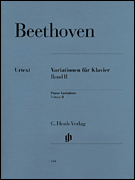
-
Beethoven, Ludwig Van
Variations, v.2 (Schmidt-Gorg)
G. Henle URTEXT edition. Includes: • 15 Variations (with Fugue) E flat major op. 35 • 32 Variations c minor WoO 80 • 5 Variations on Rule Britannia WoO 79 • 6 Easy variations G major WoO 77 • 6 Variations F major op. 34 • 6 Variations D major op. 76 • 7 Variations on God Save the King WoO 78 • 8 Variations on Tndeln und Scherzen by S¾ssmayr WoO 76 • Appendix: 8 Variations on ...
Read More
Category: Piano Composer Folios
Item: 013812
Grade:
Price: $36.95
Availability: Ships in 6 to 9 Days - View Shopping Cart
-

-
Beethoven, Ludwig Van
Variations, v.2 (Loy/Fountain)
The variation genre occupied Beethoven his whole artistic life. Collected in the second volume of G. Henle Publishers' complete edition of piano variations are compositions from his middle and later Vienna years written between 1799 and 1823. Among them are groundbreaking works such as the two sets of variations on original themes opp. 34 and 35, the Variations in C minor WoO 80, and, as the final crown jewel, the Diabelli Variations op. 120. The revised musical text of the Urtext edition, with a...
Read More
Category: Piano Composer Folios
Item: 124997
Grade:
Price: $35.95
Availability: Ships in 10 to 15 Days - View Shopping Cart
-

-
Brahms, Johannes
Ballades, op 10 (Eich/Vogt)
The Scottish ballad "Edward" from J. G. Herders anthology of folk songs "Stimmen der Volker in Liedern" made such a deep impression on Brahms that, as he told a friend, the melodies came to him effortlessly. "Edward" provided the motif for the first of four ballade compositions, musical tales of a dramatic romantic nature that were linked with memories of Clara Schumann for Brahms. Julius Grimm, to whom the pieces were dedicated, also said that "the Ballades are really for her." Robert Schumann w...
Read More
Category: Piano Solos
Item: 081326
Grade:
Price: $18.95
Availability: Ships in 6 to 9 Days - View Shopping Cart
-

-
Brahms, Johannes
Brahms: At the Piano (Hewig-Troescher)
15 Well-Known Original Pieces in Progressive Order off Difficulty.
Category: Piano Composer Folios
Item: 115364
Grade:
Price: $19.95
Availability: Ships in 10 to 15 Days - View Shopping Cart
-

-
Brahms, Johannes
Exercises (51) (Cai)
G. Henle urtext edition. Edited by Camilla Cai. Teaching the piano was an important source of income for Brahms, as it was for many nineteenth-century composers. This gave rise to collections of exercises which at first he only occasionally wrote down, but later shared with other pianists (e. g. Clara Schumann). It was only after he had largely given up this educational and pianistic activity that he considered publishing them. In order to reflect their level, he suggested "all kinds of instrumen...
Read More
Category: Piano Composer Folios
Item: 075863
Grade:
Price: $29.95
Availability: Ships in 6 to 9 Days - View Shopping Cart
-

-
Brahms, Johannes
Fantasies, op 116 (Eich)
Johannes Brahms presumably wrote the Fantasies Op. 116 at the same time as the Intermezzi Op. 117 in the summer of 1892 in Bad Ischl. His sojourn in the Salzkammergut obviously inspired Brahms to write music for solo piano, as a year later he worked on other cycles when he was there. Amongst these late melancholy piano pieces, Op. 116 is in particular characterized by opposites. Four "dreamy" - according to Clara Schumann - intermezzi are juxtaposed with three "deeply passionate" capricci. Seven ...
Read More
Category: Piano Composer Folios
Item: 123662
Grade:
Price: $15.95
Availability: Ships in 10 to 15 Days - View Shopping Cart
-

-
Brahms, Johannes
Handel Variations, op 24 (Gerlach/Theopold)
G. Henle URTEXT edition
Category: Piano Solos
Item: 013851
Grade:
Price: $16.95
Availability: Ships in 6 to 9 Days - View Shopping Cart
-

-
Brahms, Johannes
Hungarian Dances Nos 1 - 10 (Cai/Koenen)
Romantic. "No opus number" is what Brahms gave his astonished publisher to understand, when he offered him the Hungarian Dances for publication in 1869. He placed a great deal of importance on the fact that he had merely "set" popular Hungarian melodies and not composed new works as such. As true as this reservation is, it did not affect the success of these works. The Hungarian Dances are today without a doubt amongst Brahms' best-known compositions. Brahms himself made an arrangement of the dan...
Read More
Category: Piano Composer Folios
Item: 111042
Grade:
Price: $21.95
Availability: Usually Ships in 24 Hours - View Shopping Cart
-

-
Brahms, Johannes
Hungarian Dances Nos 1-10
G. Henle URTEXT edition
Category: Piano Composer Folios
Item: 013773
Grade:
Price: $20.95
Availability: Ships in 6 to 9 Days - View Shopping Cart
- p.1 (Al - Ba)
- p.2 (Ba - Ba)
- p.3 (Ba - Be)
- p.4 (Be - Br)
- p.5 (Br - Ch)
- p.6 (Ch - De)
- p.7 (De - Ha)
- p.8 (Ha - Li)
- p.9 (Li - Mo)
- p.10 (Mo - Sa)
- p.11 (Sa - Sc)
- p.12 (Sc - Sc)
- p.13 (Sc - We)
- Next >
More Options
- Use our Custom Order Page to special order items you can't find.
- Use our Catalog Order Page to order items from a printed catalog, or if you already know our catalog number for the item(s) you're interested in.
- And as always, feel free to E-mail us with your questions!
